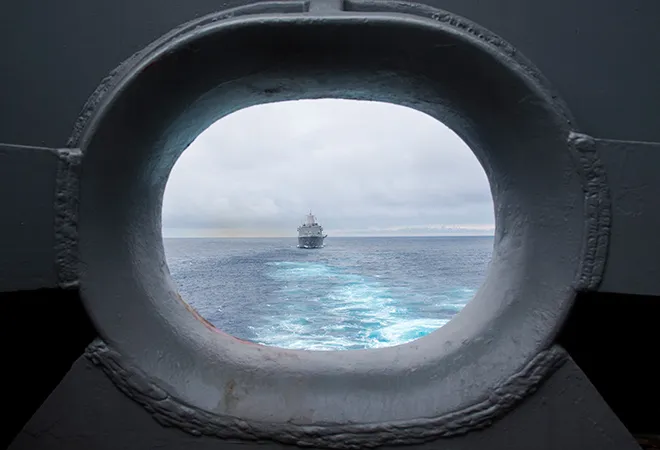In ways more than one, 2017 was the year the strategic construct of the Indo-Pacific came to being in Washington, DC. The importance of this official adoption of the notion for India cannot be overstated: by being so, India now sits firmly in US grand strategy as US officials contemplate a new template to deal with Chinese revisionism. However, while India rhetorically endorses the idea of the Indo-Pacific, three issues prevent actual operationalisation of the concept for New Delhi — geographically pertaining to India’s east, north, and west.
Pacific blues
Despite having significant economic and security interests in the western Pacific — the South China Sea, in particular — three interrelated deficits explain India’s reticence to play a larger role in the region.
First, the strategic deficit. While the Indian navy recognises that its interests the entire Indian Ocean and western Pacific Oceans, by making a distinction between its ‘primary’ and ‘secondary’ areas of interest, it effectively splits the unified strategic construct of the Indo-Pacific. More importantly, India’s lack of a formal national security strategy is a practical roadblock that prevent delineation and prioritisation of core strategic objectives. The absence of such a document has often meant that the Indian establishment has resorted to overemphasising continental threats.
Second, India continues to remain deficient when it comes to naval force-projection capabilities. India will spend a meagre 1.62 percent of its GDP on defence in financial year 2018-19, much of which will be revenue expenditure. Given that the Indian navy is the smallest of the three services in terms of budgetary allocation, this low ceiling caps its acquisitions considerably. Beyond numbers, the Indian navy has also been slow to modernise, and much of its equipment is dated.
The third and final deficit is normative. New Delhi’s understanding of constitutes freedom of navigation often sharply differs from that of the US, leading to pathologies such as the latter carrying of freedom-of-navigation operations against India as late as 2014-15. India also worries that should it adopt a tougher line on freedom of navigation in the South China Sea, China might also do the same and start foraying near the strategically-located Andaman and Nicobar Islands.
The China challenge
Beyond these proximate deficits, a more fundamental reason exists why India may be unable to play a larger role in advancing the strategic construct of the Indo-Pacific, having to do with India’s inconsistent China policy. Despite jubilation in India over China having been literally stopped in its tracks in Doklam, it took a sharp U-turn on its policy towards China beginning January 2018. Sold as a ‘reset’ of India-China ties after the Doklam crisis, the Indian government has since embarked on an intense high-profile outreach to Beijing.
Furthermore, when the Beijing-backed president of Maldives cracked down on the opposition and, in direct defiance of New Delhi, declared and then extended a state of emergency in February 2018, New Delhi's inaction was read either as a lack of options in dealing with an errant neighbour or — worse — bowing to Chinese pressure. By fact or optics, New Delhi let Beijing emerge as the winner in the latest round of shadow boxing between the two countries.
To be sure, realism dictate that a materially weaker India must do what it can to stabilise a relationship that has been going downhill on most fronts since 2016. This includes increasing areas in which India and China can cooperate in order to balance out areas of serious differences. The problem with this argument though is that this is precisely the approach New Delhi tried before Doklam — and it didn't help.
Western entanglements
Former commander of the United States Pacific Command (PACOM) Admiral Harry Harris is fond of reminding his Indian audiences that PACOM stretches from “Hollywood to Bollywood.” One of the main discordant notes in situating India in the Indo-Pacific is divergent Indian and U.S. positions on happenings off the coast of Bollywood (Mumbai), and into the western Indian Ocean and the troubled littorals there — Pakistan and Iran, in particular.
The basic problem with the American desire to situate India as a leading power in the Indo-Pacific is organisational, and lies with the peculiarity of India being in PACOM’s area of responsibility (AOR). India’s troubles have historically been with Pakistan, which is in CENTCOM’s AOR. This problem has been exacerbated by the fact that while the Indian Navy and PACOM have developed a close working relationship, such is not the case between CENTCOM (and its naval subordinate, NAVCENT) and India’s Western Naval Command.
The Indian conception of the Indo-Pacific includes the entire Indian Ocean, with the implication that Pakistan is an Indo-Pacific littoral, albeit a troubled one. And, if the United States urges regional stakeholders to accept that North Korea is a trouble spot in the Indo-Pacific, it can be argued that Pakistan should also be marked as such in the US strategy for the region. Whether India fully signs on to the United States’ conception of the Indo-Pacific will depend on whether counterterrorism — and modifying Pakistan’s behaviour — can be brought to its regional agenda.
This commentary is adapted from the authors’ article “Is India Ready for the Indo-Pacific,” published in the Summer 2018 issue of The Washington Quarterly.
The views expressed above belong to the author(s). ORF research and analyses now available on Telegram! Click here to access our curated content — blogs, longforms and interviews.




 PREV
PREV


